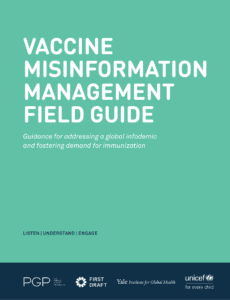Misinformation Alerts
Knowing what misinformation is being shared can help you generate effective messaging.
These insights are based on a combination of automated media monitoring and manual review by public health data analysts. Media data are publicly available data from many sources, such as social media, broadcast television, newspapers and magazines, news websites, online video, blogs, and more. Analysts from the Public Good Projects triangulate this data along with other data from fact checking organizations and investigative sources to provide an accurate, but not exhaustive, list of currently circulating misinformation.
Misinformation Alerts
Knowing what misinformation is being shared can help you generate effective messaging.
These insights are based on a combination of automated media monitoring and manual review by public health data analysts. Media data are publicly available data from many sources, such as social media, broadcast television, newspapers and magazines, news websites, online video, blogs, and more. Analysts from the Public Good Projects triangulate this data along with other data from fact checking organizations and investigative sources to provide an accurate, but not exhaustive, list of currently circulating misinformation.Alerts are categorized as high, medium, and low risk.
- High risk alerts: Narratives with widespread circulation across communities, high engagement, exponential velocity, and a high potential to impact health decisions. Are often more memorable than accurate information.
- Medium risk alerts: Narratives that are circulating in priority populations and pose some threat to health. Potential for further spread due to the tactics used or because of predicted velocity. Often highlights the questions and concerns of people.
- Low risk alerts: Narratives that are limited in reach, don’t impact your community, or lack the qualities necessary for future spread. May indicate information gaps, confusion, or concerns.
The global safety study that identified several extremely rare risks associated with COVID-19 vaccines is being distorted and misrepresented online. Some posts include lists and misleading graphs of the increased risks identified in the study, while others contradict the study’s findings to overstate the risks and falsely insinuate that health authorities denied risks that have been formally recognized since 2021.
Recommendation: The safety study is being used to spread the false narratives that COVID-19 vaccines are unsafe and have more risks than previously acknowledged. These narratives—based on deliberate misrepresentations of legitimate data—may weaken public confidence in vaccines. Talking points may emphasize that the largest global safety study to date confirmed just how safe COVID-19 vaccines are and the extreme rarity of serious adverse reactions. The study’s large scale allowed for the detection of risks that smaller studies may miss because they are so rare. Messaging may highlight that a study that found extremely rare risks, such as seven cases of acute disseminated encephalomyelitis out of 36 million Moderna vaccinations, does not support the false narrative that COVID-19 vaccines cause widespread death and serious health complications. Messaging may also explain that the safety of COVID-19 vaccines has been established in numerous large-scale studies, including the recent global safety study. Fact Checking Source(s): AFP, Health Feedback 
Several viral posts falsely claimed that COVID-19 vaccine recipients are ineligible to donate blood through the Red Cross. Days later, an audio clip of an alleged Red Cross official saying that blood is not separated by vaccination status has caused outrage.
Recommendation: Responding to this false claim may detract from priority talking points. However, due to its widespread circulation, organizations may wish to address the misinformation. Emphasizing that there are no restrictions or waiting periods for people who received any COVID-19 vaccines authorized in the U.S. and clarifying that Red Cross policy requires people who received live attenuated vaccines to wait two weeks before donating blood is recommended. Fact-checking sources: Full Fact, AP News
In an interview with a popular right-wing commentator, a tech entrepreneur-turned-vaccine conspiracist repeated several myths about COVID-19 vaccines. A clip from the video that has millions of views repeats the debunked claim that COVID-19 vaccines caused 17 million deaths and are the most dangerous vaccine of all time.
Recommendation: Misrepresentations of legitimate research fuel the persistent false narrative that COVID-19 vaccines are less safe than the public was led to believe. Debunking messaging may emphasize that the study did not identify new COVID-19 vaccine risks but rather confirmed previously reported risks like myocarditis and the extreme rarity of such events. Prebunking messaging may also continue to emphasize that the risk of serious adverse reactions after COVID-19 vaccination is far lower than the risk of COVID-19 infection. Fact Checking Source(s): Scripps News, University of Auckland, IDSA
Several posts are circulating images of a flu vaccine package insert, claiming that it proves flu vaccines are an ineffective scam. Other posts claim that flu vaccines are untested and may be linked to cancer and sterility.
Recommendation: Emphasizing that decades of research show that flu vaccines protect against flu infection, severe illness, and complications is recommended. Messaging may explain that the flu vaccine is extremely safe and not linked to any serious health concerns, including cancer or infertility. Fact Checking Source(s): Mayo Clinic, FactCheck.org, Health Feedback, Reuters 
A widely circulated post claims that the WHO administered 50 million smallpox vaccines in Africa that were laced with HIV. The post includes an image of a 1987 news article promoting the conspiracy theory that vaccines “triggered the AIDS virus.”
Recommendation: The persistence of this myth increases its risk. Debunking messaging may explain why the conspiracy theory was immediately and universally rejected by experts, who note that the same smallpox vaccines were administered globally without triggering an AIDS outbreak. Fact Checking Source(s): Full Fact
Some social media accounts expressed outrage over a Pfizer ad about future cancer treatments that aired during the Super Bowl. Some posts criticized a starting player’s participation in a previous Pfizer COVID-19 vaccine ad, while others accused the pharmaceutical giant of producing cancer drugs to treat so-called “turbo cancers” allegedly linked to COVID-19 vaccines.
Recommendation: The claims received considerable attention—and pushback—due to the high-profile nature of the game. Debunking messaging may explain that turbo cancer is a made-up term circulated by vaccine opponents and that the claim that mRNA COVID-19 vaccines cause or accelerate cancer is an anti-vaccine myth. Talking points may emphasize that over three years of scientific research and safety monitoring have found no link between any COVID-19 vaccine and cancer. Fact Checking Source(s): FactCheck, Science-Based Medicine 
Several vaccine opponents published a review article that questions mRNA COVID-19 vaccine safety. The paper calls to ban the vaccines and promotes the baseless claim that COVID-19 vaccines killed 14 times as many people as they have saved.
Recommendation: Fact-Checking Source(s): PolitiFact, CIDRAP
Many posts sharing the paper emphasize its peer-reviewed status, which lends it the appearance of credibility. Messaging may highlight that although the paper is peer-reviewed, it is published in a journal that has been labeled “predatory” and has been criticized for its controversial post-publication peer-review process. Messaging may also emphasize that the review’s claim about vaccine-related deaths is based on unverified and noncredible data. Independent analyses of global data estimate that COVID-19 vaccines have saved millions of lives worldwide.
A popular video circulating online repeats the false claim that vaccine manufacturers suppressed hydroxychloroquine and ivermectin to ensure the authorization of COVID-19 vaccines.
Recommendation: The persistence of false claims about fake COVID-19 cures increases their risk. Debunking messaging may emphasize that both hydroxychloroquine and ivermectin have been subject to large clinical trials and were found to be ineffective against COVID-19 at any dose or duration. Talking points may continue to highlight data showing the effectiveness of COVID-19 vaccines. Fact-checking sources: KUMC, JAMA, Penn Medicine
During a right-wing political commentator’s interview with a writer who opposes COVID-19 vaccines, there was speculation about the safety of mRNA COVID-19 vaccines. The writer suggested that mRNA vaccines weaken the immune system and promoted the conspiracy theory that China may release a bioweapon targeting those who received mRNA vaccines.
Recommendation: Responding to each conspiracy theory may detract from priority talking points. Continuing to emphasize the well-established safety of COVID-19 vaccines is recommended. Fact-checking sources: CDC
Several trending posts circulate false claims about HPV vaccine safety and effectiveness. The posts falsely claim that HPV vaccines don’t prevent cervical cancer and that the vaccines cause autoimmune diseases, miscarriages, birth defects, and deaths in young adults.
Recommendation: Messaging may highlight that vaccine opponents have circulated myths about HPV vaccines since their introduction in 2006. In the intervening years, hundreds of millions of doses of the vaccine have been administered globally with no serious safety concerns. Data from multiple countries, including the U.S. and the U.K., show a decrease in cervical cancer rates in HPV-vaccinated populations, putting some countries on track to eliminate the disease. Fact Checking Source(s): American Cancer Society, WHO
Alerts are categorized as high, medium, and low risk.
- High risk alerts: Narratives with widespread circulation across communities, high engagement, exponential velocity, and a high potential to impact health decisions. Are often more memorable than accurate information.
- Medium risk alerts: Narratives that are circulating in priority populations and pose some threat to health. Potential for further spread due to the tactics used or because of predicted velocity. Often highlights the questions and concerns of people.
- Low risk alerts: Narratives that are limited in reach, don’t impact your community, or lack the qualities necessary for future spread. May indicate information gaps, confusion, or concerns.
Vaccine Misinformation Guide
Get practical tips for addressing misinformation in this new guide. Click image to download, or see highlights.



